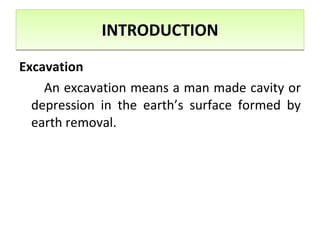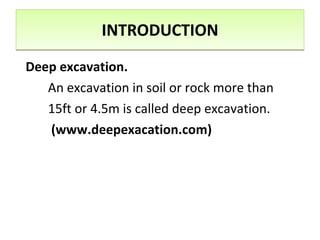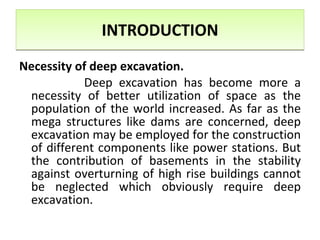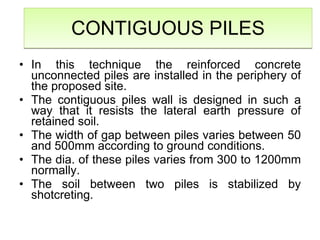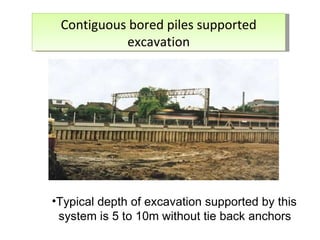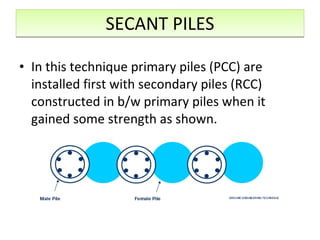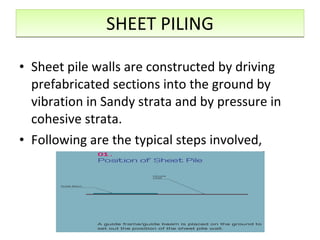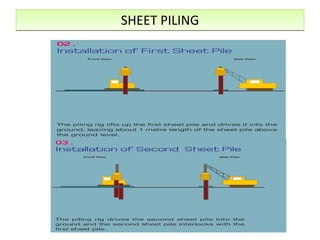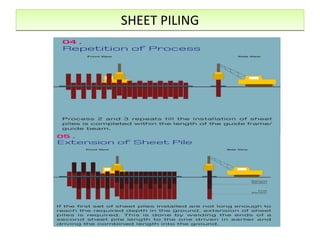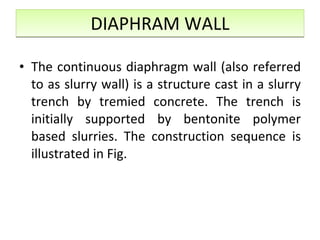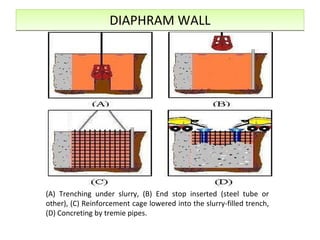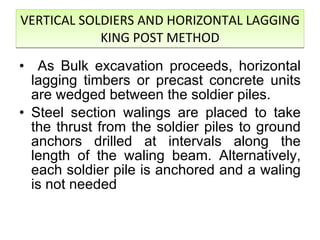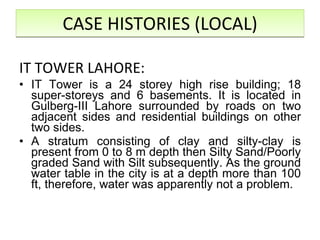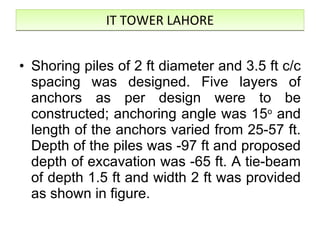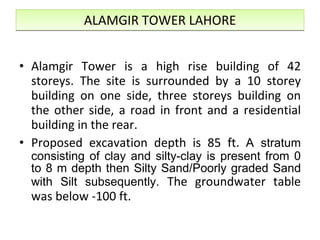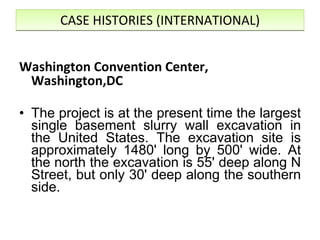Deep excavation
- 1. DEEP EXCAVATION TECHNIQUES PRESENTED BY: FAHAD MUSHTAQ (2007-MS-GEO-12)
- 2. CONTENTS Introduction Deep Excavation Techniques Case Histories
- 3. INTRODUCTION Excavation An excavation means a man made cavity or depression in the earth’s surface formed by earth removal.
- 4. INTRODUCTION Deep excavation. An excavation in soil or rock more than 15ft or 4.5m is called deep excavation. (www.deepexacation.com)
- 5. INTRODUCTION Open excavation. It means an excavation without any retaining system by providing suitable slope of excavation such as 1:2, when surrounding allows.
- 6. INTRODUCTION Retained deep excavation. A deep excavation in soil or rock with some retaining system, usually in populated areas.
- 7. INTRODUCTION Necessity of deep excavation. Deep excavation has become more a necessity of better utilization of space as the population of the world increased. As far as the mega structures like dams are concerned, deep excavation may be employed for the construction of different components like power stations. But the contribution of basements in the stability against overturning of high rise buildings cannot be neglected which obviously require deep excavation.
- 8. RETAINING SYSTEMS FOR DEEP EXCAVATION Followings are the common systems for supporting deep excavation
- 9. CONTIGUOUS PILES In this technique the reinforced concrete unconnected piles are installed in the periphery of the proposed site. The contiguous piles wall is designed in such a way that it resists the lateral earth pressure of retained soil. The width of gap between piles varies between 50 and 500mm according to ground conditions. The dia. of these piles varies from 300 to 1200mm normally. The soil between two piles is stabilized by shotcreting.
- 10. Contiguous bored piles supported excavation Typical depth of excavation supported by this system is 5 to 10m without tie back anchors
- 11. SECANT PILES In this technique primary piles (PCC) are installed first with secondary piles (RCC) constructed in b/w primary piles when it gained some strength as shown.
- 12. SECANT PILES Pile overlap is typically in order of 3in. The principal disadvantages of contiguous pile walls, the gaps between piles and the resulting problems of lack of waterproofness are effectively overcome by interlocking or secant piles.
- 13. SHEET PILING Sheet pile walls are constructed by driving prefabricated sections into the ground by vibration in Sandy strata and by pressure in cohesive strata. Following are the typical steps involved,
- 14. SHEET PILING
- 15. SHEET PILING
- 16. DIAPHRAM WALL The continuous diaphragm wall (also referred to as slurry wall) is a structure cast in a slurry trench by tremied concrete. The trench is initially supported by bentonite polymer based slurries. The construction sequence is illustrated in Fig.
- 17. DIAPHRAM WALL (A) Trenching under slurry, (B) End stop inserted (steel tube or other), (C) Reinforcement cage lowered into the slurry-filled trench, (D) Concreting by tremie pipes.
- 18. VERTICAL SOLDIERS AND HORIZONTAL LAGGING KING POST METHOD The method consists of boring holes on the wall line, typically at 2 to 3m centers, placing vertical steel universal beam or column soldier piles within the holes and concreting the base of each joist below final formation level. Lean mix concrete is often used for this purpose. In suitable soils the steel soldier pile may be driven. When the soldier pile is to be extracted the base of each joist is supported by gravel backfilled to formation level.
- 19. VERTICAL SOLDIERS AND HORIZONTAL LAGGING KING POST METHOD As Bulk excavation proceeds, horizontal lagging timbers or precast concrete units are wedged between the soldier piles. Steel section walings are placed to take the thrust from the soldier piles to ground anchors drilled at intervals along the length of the waling beam. Alternatively, each soldier pile is anchored and a waling is not needed
- 20. VERTICAL SOLDIERS AND HORIZONTAL LAGGING KING POST METHOD
- 21. CASE HISTORIES (LOCAL) IT TOWER LAHORE: IT Tower is a 24 storey high rise building; 18 super-storeys and 6 basements. It is located in Gulberg-III Lahore surrounded by roads on two adjacent sides and residential buildings on other two sides. A stratum consisting of clay and silty-clay is present from 0 to 8 m depth then Silty Sand/Poorly graded Sand with Silt subsequently. As the ground water table in the city is at a depth more than 100 ft, therefore, water was apparently not a problem.
- 22. IT TOWER LAHORE Shoring piles of 2 ft diameter and 3.5 ft c/c spacing was designed. Five layers of anchors as per design were to be constructed; anchoring angle was 15 o and length of the anchors varied from 25-57 ft. Depth of the piles was -97 ft and proposed depth of excavation was -65 ft. A tie-beam of depth 1.5 ft and width 2 ft was provided as shown in figure.
- 23. IT TOWER LAHORE
- 24. ALAMGIR TOWER LAHORE Alamgir Tower is a high rise building of 42 storeys. The site is surrounded by a 10 storey building on one side, three storeys building on the other side, a road in front and a residential building in the rear. Proposed excavation depth is 85 ft. A stratum consisting of clay and silty-clay is present from 0 to 8 m depth then Silty Sand/Poorly graded Sand with Silt subsequently. The groundwater table was below -100 ft.
- 25. ALAMGIR TOWER LAHORE Contiguous piling with anchors and tie beam was adopted as the soil retaining system. The depth of the piles constructed was more than -96 ft. Anchoring at an angle of 15 o was to be done in 9 layers as shown in Fig
- 27. CASE HISTORIES (INTERNATIONAL) Washington Convention Center, Washington,DC The project is at the present time the largest single basement slurry wall excavation in the United States. The excavation site is approximately 1480' long by 500' wide. At the north the excavation is 55' deep along N Street, but only 30' deep along the southern side.
- 28. Washington Convention Center, Washington, DC Slurry wall panels adjacent to the subway at 7th Street are 3.5'-thick, while at all other location the wall thickness is 3.0'. The slurry walls also provide water cut-off and thus minimize the dewatering efforts that are required. Temporary bracing for this excavation consists of a mix of tiebacks and prestressed rakers, depending on location.
- 29. Washington Convention Center, Washington, DC The largest slurry wall deflection, 0.7", occurred at the deepest section of the excavation along N Street, where the wall was braced by three levels of tiebacks. This deflection was not measured directly but it was reconstructed from data before and after re-initialization of inclinometers took place. The wall slightly bent only below the lowest tieback level, and above that showed very little to no bending. Cantilever movements dominated until the second tieback level was installed. The largest horizontal soil movement, 0.75", occurred at the southern side where the excavation was only 30' deep, braced by an upper level of tiebacks and a lower level of rakers.
- 30. REFRENCES Puller. M. (2003), Deep Excavation: a practical manual , 2 nd edition. http://www.deepexcavation.com
- 31. THANKS



